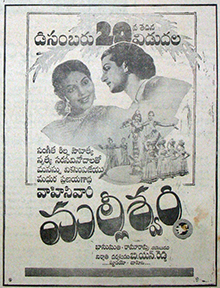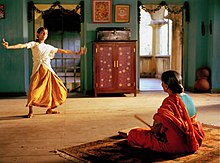
Shekhar Kulbhushan Kapur is an Indian filmmaker and actor. Born into the Anand-Sahni family, Kapur is the recipient of several accolades, including a BAFTA Award, a National Film Award, a National Board of Review Award and three Filmfare Awards, in addition to nomination for a Golden Globe Award.

Bandit Queen is a 1994 Indian Hindi-language biographical action-adventure film based on the life of Phoolan Devi as covered in the book India's Bandit Queen: The True Story of Phoolan Devi by the Indian author Mala Sen. It was written, produced, and directed by Shekhar Kapur and starred Seema Biswas as the title character. The music was composed by Ustad Nusrat Fateh Ali Khan. The film won the National Film Award for Best Feature Film in Hindi, Filmfare Critics Award for Best Movie and Best Direction for that year. The film was premiered in the Directors' Fortnight section of the 1994 Cannes Film Festival, and was screened at the Edinburgh Film Festival. The film was selected as the Indian entry for the Best Foreign Language Film at the 67th Academy Awards, but was not accepted as a nominee.

Bombay is a 1995 Indian Tamil-language romantic drama film written and directed by Mani Ratnam, starring Arvind Swamy and Manisha Koirala. The film tells the story of an inter-religious family in Bombay before and during the Bombay riots, which took place between December 1992 and January 1993 after the demolition of the Babri Masjid led to religious tensions between Hindu and Muslim communities. It is the second installment in Ratnam's trilogy of films that depict human relationships against a background of Indian politics, including Roja (1992) and Dil Se.. (1998).

Parineeta is a 2005 Indian Hindi-language musical romance film adaptation of Sarat Chandra Chattopadhyay's 1914 Bengali novella of the same name. Directed by debutant Pradeep Sarkar, it was based upon a screenplay by the film's producer, Vidhu Vinod Chopra. The film stars Sanjay Dutt, Saif Ali Khan, and Vidya Balan in lead roles, with Raima Sen, Sabyasachi Chakrabarty and Dia Mirza in supporting roles. The film has several notable allusions to Indian literature and cinema.

Ramya Krishnan, also credited as Ramya Krishna is an Indian actress. She has appeared in five languages: Telugu, Tamil, Kannada, Malayalam, and Hindi. Ramya has won four Filmfare Awards, three Nandi Awards, and a Tamil Nadu State Film Award Special Prize.

Bangalore Saroja Devi is an Indian actress who has acted in Kannada, Tamil, Telugu and Hindi films. She acted in around 200 films over seven decades. She is known by the epithets "Abhinaya Saraswathi" in Kannada and "Kannadathu Paingili" in Tamil. She is one of the most successful actresses in the history of Indian cinema.

Telugu cinema, also known as Tollywood, is the segment of Indian cinema dedicated to the production of motion pictures in the Telugu language, widely spoken in the states of Andhra Pradesh and Telangana. Telugu cinema is based in Film Nagar, Hyderabad. As of 2021, Telugu cinema is the largest film industry in India in terms of box-office. Telugu films sold 23.3 crore tickets in 2022, the highest among various film industries in India.
The Indian Film Festival of Los Angeles(IFFLA) is an annual film festival held in Los Angeles, California. Established by Christina Marouda in 2003, as a nonprofit organization devoted to paving the way for a greater appreciation of Indian cinema and diverse culture by providing the public with a selection of films from and about the Indian diaspora by Indian and international filmmakers.

Sita Sings the Blues is a 2008 American animated musical romantic comedy-drama film written, directed, produced and animated by American artist Nina Paley. It intersperses events from the Ramayana, light-hearted but knowledgeable discussion of historical background by a trio of Indian shadow puppets, musical interludes voiced with tracks by Annette Hanshaw and scenes from the artist's own life. The ancient mythological and modern biographical plot are parallel tales, sharing numerous themes.

Ananda Bhairavi is a 1983 Indian bilingual dance film, simultaneously shot in Telugu and Kannada languages, written, and directed by Jandhyala. It starred Girish Karnad, Kathak dancer Malavika Sarkar, Rajesh and "Natyacharya" Bhagavathula Venkata Rama Sarma as a male classical dancer in this film. The film was premiered at International Film Festival of India. The film received positive reviews and has garnered the four state Nandi Awards.

Arunima Kumar, Sangeet Natak Akademi Yuva Puraskar awardee for the year of 2008 for Kuchipudi. As a young girl of 9, Arunima acted in the ballet Amrapali. The Kuchipudi Dance Academy formally launched her in 1995 where she performed her Arangetram at the Triveni Kala Sangam, New Delhi.

Mallishwari is a 1951 Indian Telugu-language historical romance film produced and directed by B. N. Reddy under his banner Vauhini Studios. P. Bhanumathi and N. T. Rama Rao star as a couple – Nagaraju and Mallishwari – who are separated by Mallishwari's greedy mother. Mallishwari is sent to the king's palace according to the custom of "Rani Vasam", a tradition during the Vijayanagara Empire wherein young women were fetched to the palace with an offering of gold and jewellery to their parents. The rest of the film focuses on the consequences faced by Nagaraju when he, against all rules, surreptitiously enters the palace to meet Mallishwari.

Gayathri Govind, is an Indian classical dancer, choreographer, actor and the winner of Asianet's Vodafone Thakadimi in 2008.
Kala, known professionally as Kala Master, is an Indian choreographer. She is the director of the Indian reality dance talent show, Maanada Mayilada – where she is one of the three judges. She was awarded the National Film Award for Best Choreography in 2000 for her folk dance sequences in the Malayalam film, Kochu Kochu Santhoshangal. She is also classically trained in dance forms such as Bharatanatyam, Kuchipudi and Kathak.
Sadhana better known by her stage name Shari is an Indian actress. She was a prominent lead actress from 1982 to 1995 in Malayalam, Tamil, Kannada, and Telugu films.
Elam Endira Devi, is an Indian classical dancer and teacher, known for her expertise and scholarship in the classical dance form of Manipuri, especially in the genres of Lai Haraoba and Raas. The Government of India honored her, in 2014, with the Padma Shri, the fourth highest civilian award, for her services to the field of art and culture.

Bhale Bhale Magadivoy is a 2015 Indian Telugu-language romantic comedy film written and directed by Maruthi. Produced by Bunny Vasu under the production companies GA2 Pictures and UV Creations, Bhale Bhale Magadivoy stars Nani and Lavanya Tripathi, with Murali Sharma, Ajay, Naresh, Sithara, and Vennela Kishore in supporting roles. The film revolves around Lucky, an absent-minded plant scientist and his efforts to hide his inherent memory-related flaws from Nandana, a benevolent Kuchipudi dancer with whom he is in a relationship.

Ananda Shankar Jayant is an Indian classical dancer, choreographer, scholar and bureaucrat, known for her proficiency in the classical dance forms of Bharatanatyam and Kuchipudi. She is the first woman officer in the Indian Railway Traffic Service on South Central Railway and her 2009 TED talk is ranked among the top twelve Incredible TED talks on cancer. She is a recipient of Sangeet Natak Akademi Award, Kalaimamani Award of the Government of Tamil Nadu and Kala Ratna Award of the Government of Andhra Pradesh. The Government of India awarded her the fourth highest civilian honour of the Padma Shri, in 2007, for her contributions to arts.
Hari Teja is an Indian actress and television presenter, who works in Telugu-language films and television. She is also a professional Kuchipudi dancer. She contested on the reality TV show Bigg Boss 1, and stood in third place.
Byrraju Sandhya Raju is an Indian Kuchipudi dancer and actress. She is recipient of a National Film Award.



















